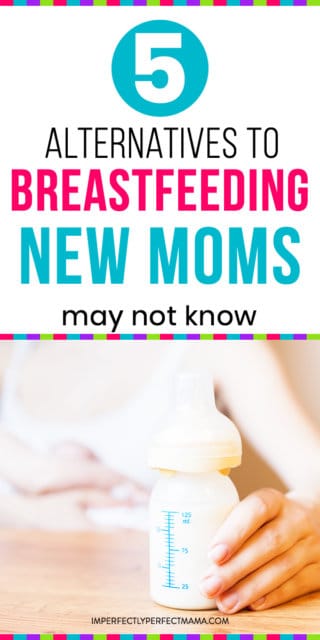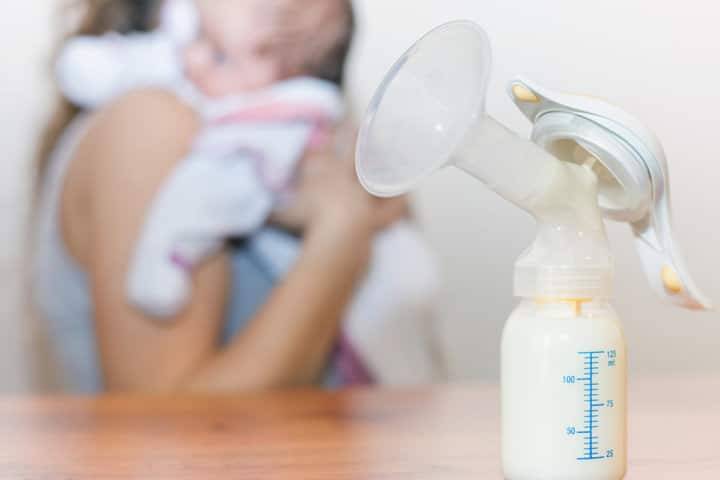Breastfeeding doesn’t always work out for every new mom.

There are many things that could go wrong – lack of supply, inverted nipples, troubles latching, medical complications and the list goes on and on.
Some women choose not to breastfeed, and others simply cannot.
You can read about my own breastfeeding story here.
So what do we do when we can’t or don’t have the desire to breastfeed?
Worry not!
There are quite a few alternatives to breastfeeding out there, here are just a few:
Supplemental Nursing System (SNS)
What is a Supplemental Nursing System?
Essentially, it is a very thin feeding tube, attached to a bag or bottle of milk or formula, that you place next to your nipple while baby is feeding.
When baby is latched on and sucking, he gets milk from the nipple, as well as the contents of the bottle through the tube.
So, maybe this isn’t really an “alternative to breastfeeding” as much as it is an “additive to breastfeeding” since you are still breastfeeding.
When would you use a SNS?
Supplemental Nursing Systems are not for everyone.
If you are still trying your best to breastfeed, but have a low supply, or if baby needs additional nutrients, a SNS could be used. SNS can also be used by moms of adopted babies to get the same bonding experience with their baby as the birth mom would.
Benefits of SNS
- You can ensure baby gets all the nutrients he needs while still breastfeeding
- SNS will help mom’s milk supply come in, since the baby continues to suck on the dry breast while using the SNS
- Trains baby to suck properly by creating a vacuum at the nipple
- Allows adopted babies to be breastfed by adoptive mom
- You can easily make one at home with the proper tubes and a bottle
Nipple Shields
A shield is a magical little silicone piece that covers your nipple while breastfeeding to help protect you and help your baby get a proper latch.
Personally, I used a shield and it helped me to continue breastfeeding longer. Medela sells a few different models that are budget-friendly.
Shields can be used when you have cracked and sore nipples, alongside lanolin or another nipple cream until they heal.
They can also be used if your baby cannot latch and help baby learn the proper technique.
When I was using a shield, my breasts were engorged to the point of my baby being unable to latch at all. The Shield creates a suction on the nipple, and it is soft enough that the baby can latch onto it with ease.
Benefits of the Shield
- Allows you and baby to continue breastfeeding even when you normally wouldn’t be able to ( sore/cracked nipples, engorged, bad latch etc.)
- Fairly cheap – approximately less than $10
- Simple solution to a lot of breastfeeding problems
- Easy to use and clean
- Reusable
Exclusive Pumping

With exclusive pumping, the mother uses a breast pump (usually on a pretty strict schedule) and the milk she expresses is the only source of food for baby.
Baby does not get milk directly from the breast and baby does not supplement with formula.
This method could be implemented when baby cannot latch property, or if Mom simply does not find breastfeeding enjoyable.
This is also a great way for Dad or other family members to bond with the baby over feedings while still getting the nutrients of breastmilk. If I had known exclusive pumping was an option when I was giving up breastfeeding, my baby would have been drinking breastmilk much longer.
Benefits of exclusive pumping
- Baby gets the benefits of breastmilk without breastfeeding
- Baby bonds with Dad or other family members while feeding
- Extend the period of time when baby drinks breastmilk without draining Mom’s energy with breastfeeding
- Allows babies with latching or other feeding issues to drink breastmilk
Human Donor Milk
Did you know that there are banks (sometimes called depot’s) all around the world to help Mom’s who can’t produce milk?
These banks don’t hold money like the traditional bank, but instead they hold donated breastmilk. Any mom who has a low milk supply or no milk supply at all can go to these banks and receive breastmilk to feed to their baby.
Mom’s with an over abundance of breastmilk, or who simply don’t use their milk can pump donate it to a breastmilk bank/depot for other moms to use as an alternative to breastfeeding.
Benefits of Human Donor Milk
- Baby is getting the benefits of breastmilk without breastfeeding
- Anyone, rather than mom only, can feed baby and bond over feedings
- Milk has been screened and pasteurized to ensure Baby is getting the best milk
- No stress over Mom’s lack of milk supply
Formula
This has to be the most popular alternative to breastfeeding, which is why I am mentioning it last.
Formula is a powdered substance that you mix with pre-boiled water to feed to your baby through a bottle. It is made with the ingredients and vitamins that your baby requires to be healthy throughout infancy, and therefore it is not required to give your baby a daily vitamin D drop as it is with breastfeeding.
Benefits of Formula
- Baby doesn’t require extra vitamins
- It is much easier than breastfeeding
- Allows mother’s who cannot produce milk (for whatever reason) or have babies who have feeding issues
- Anyone, rather than mom only, can feed baby and bond over feedings
- Formula can be bought in most grocery or department stores
When my baby was having feeding problems after birth, the hospital did not mention any other options aside from breastfeeding and formula. I didn’t do enough research and I was not properly informed.
I am writing this article to help spread awareness of the alternative options out there. Breastmilk is best for your baby and I hope to help you to provide your baby with the best nutrients as long as possible.
Do you know of any other breastfeeding alternatives? Mention them in the comments below!




10 Comments